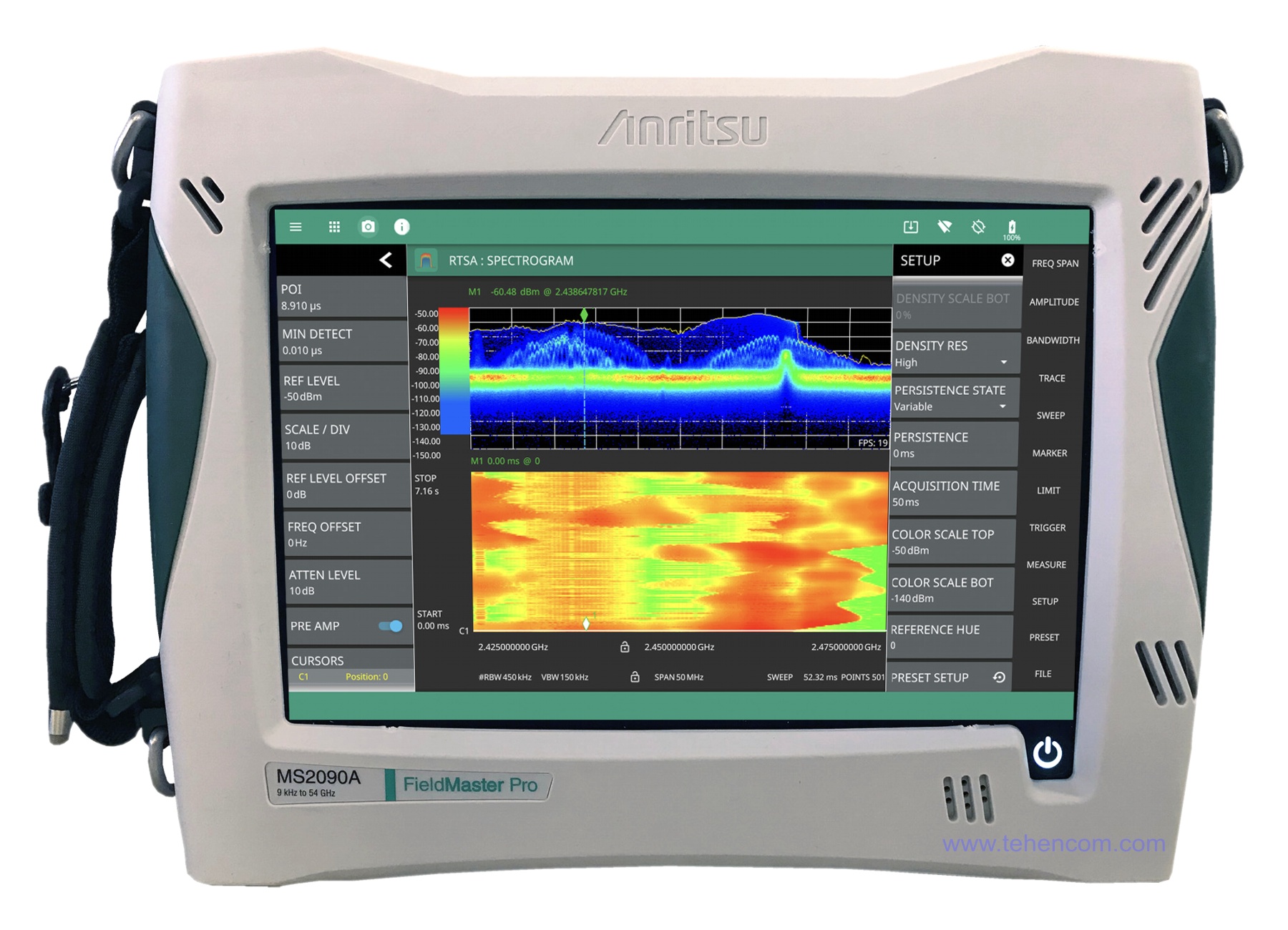Anritsu MS276xA series of ultra-portable spectrum analyzers up to 170 GHz
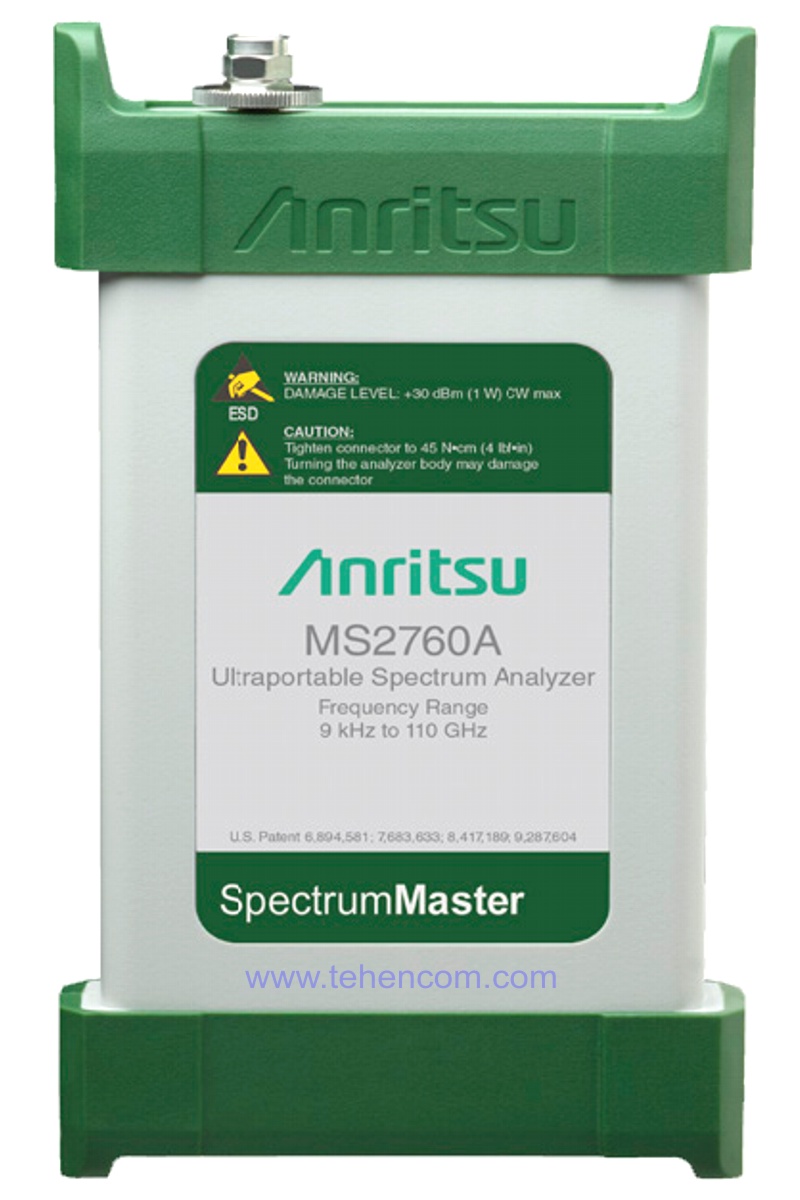
Brief description of the series
The Anritsu MS276xA Spectrum Master series of ultra-portable spectrum analyzers features record-breaking low prices and a miniature design, which allows for a number of applications to eliminate cables and connect directly to the signal source. Depending on the model, the maximum operating frequency range is: 32 GHz, 44 GHz, 50 GHz, 70 GHz, 90 GHz, 110 GHz, 145 GHz and 170 GHz. In total, the series contains sixteen models: eight models of the MS2760A line with an initial frequency of 9 kHz and eight models of the MS2762A line with improved sensitivity and an initial frequency of 6 GHz.
Typical applications for Anritsu MS276xA spectrum analyzers: development and production of microwave and millimeter wave devices, radio relay stations, satellite communications, electronic warfare, radars, 3G/4G/5G networks, 802.11ad/WiGig and many other promising tasks. A complete description of all the characteristics of the MS276xA series can be downloaded below on this page in the Documentation section.
All models of the series
The Anritsu MS276xA series consists of sixteen models, which are presented in this interactive table. To see all the characteristics of certain models, add them to the comparison.
| Model |
Maximum frequency
|
Minimum frequency
|
Maximum amplitude
|
Average noise DANL
|
SSB phase noise
|
Weight
|
|---|---|---|---|---|---|---|
|
MS2760A-0032
|
32 GHz | 9 kHz 1 Hz | +10 dBm | -131 dBm -134 dBm | -95 dBc/Hz -104 dBc/Hz | 0.255 kg |
|
MS2762A-0032
|
32 GHz | 6 GHz | 0 dBm | -135 dBm -142 dBm | -94 dBc/Hz -98 dBc/Hz | 0.255 kg |
|
Expert's choice
MS2760A-0044
|
44 GHz | 9 kHz 1 Hz | +10 dBm | -131 dBm -134 dBm | -95 dBc/Hz -104 dBc/Hz | 0.255 kg |
|
MS2762A-0044
|
44 GHz | 6 GHz | 0 dBm | -135 dBm -142 dBm | -94 dBc/Hz -98 dBc/Hz | 0.255 kg |
|
MS2760A-0050
|
50 GHz | 9 kHz 1 Hz | +10 dBm | -131 dBm -134 dBm | -95 dBc/Hz -104 dBc/Hz | 0.255 kg |
|
MS2762A-0050
|
50 GHz | 6 GHz | 0 dBm | -135 dBm -142 dBm | -94 dBc/Hz -98 dBc/Hz | 0.255 kg |
|
Expert's choice
MS2760A-0070
|
70 GHz | 9 kHz 1 Hz | +10 dBm | -131 dBm -134 dBm | -95 dBc/Hz -104 dBc/Hz | 0.255 kg |
|
MS2762A-0070
|
70 GHz | 6 GHz | 0 dBm | -135 dBm -142 dBm | -94 dBc/Hz -98 dBc/Hz | 0.255 kg |
|
MS2760A-0090
|
90 GHz | 9 kHz 1 Hz | +10 dBm | -131 dBm -134 dBm | -95 dBc/Hz -104 dBc/Hz | 0.255 kg |
|
MS2762A-0090
|
90 GHz | 6 GHz | 0 dBm | -135 dBm -142 dBm | -94 dBc/Hz -98 dBc/Hz | 0.255 kg |
|
MS2760A-0110
|
110 GHz | 9 kHz 1 Hz | +10 dBm | -131 dBm -134 dBm | -95 dBc/Hz -104 dBc/Hz | 0.255 kg |
|
MS2762A-0110
|
110 GHz | 6 GHz | 0 dBm | -135 dBm -142 dBm | -94 dBc/Hz -98 dBc/Hz | 0.255 kg |
|
MS2760A-0145
|
145 GHz | 9 kHz 1 Hz | +10 dBm | -131 dBm -134 dBm | -95 dBc/Hz -104 dBc/Hz | 0.255 kg |
|
MS2762A-0145
|
145 GHz | 6 GHz | 0 dBm | -135 dBm -142 dBm | -94 dBc/Hz -98 dBc/Hz | 0.255 kg |
|
Expert's choice
MS2760A-0170
|
170 GHz | 9 kHz 1 Hz | +10 dBm | -131 dBm -134 dBm | -95 dBc/Hz -104 dBc/Hz | 0.255 kg |
|
MS2762A-0170
|
170 GHz | 6 GHz | 0 dBm | -135 dBm -142 dBm | -94 dBc/Hz -98 dBc/Hz | 0.255 kg |
Main features of the series
Frequency: 9 kHz – 32 GHz (model MS2760A-0032); 6 GHz – 32 GHz (model MS2762A-0032).
Frequency: 9 kHz – 44 GHz (model MS2760A-0044); 6 GHz – 44 GHz (model MS2762A-0044).
Frequency: 9 kHz – 50 GHz (model MS2760A-0050); 6 GHz – 50 GHz (model MS2762A-0050).
Frequency: 9 kHz – 70 GHz (model MS2760A-0070); 6 GHz – 70 GHz (model MS2762A-0070).
Frequency: 9 kHz – 90 GHz (model MS2760A-0090); 6 GHz – 90 GHz (model MS2762A-0090).
Frequency: 9 kHz – 110 GHz (model MS2760A-0110); 6 GHz – 110 GHz (model MS2762A-0110).
Frequency: 9 kHz – 145 GHz (model MS2760A-0145); 6 GHz – 145 GHz (model MS2762A-0145).
Frequency: 9 kHz – 170 GHz (model MS2760A-0170); 6 GHz – 170 GHz (model MS2762A-0170).
Resolution (RBW): 1 Hz – 3 MHz.
Dynamic Range: More than 103 dB (MS2760A models).
Dynamic Range: More than 108 dB (MS2762A models).
Amplitude: +10 dBm to -136 dBm (MS2760A models).
Amplitude: 0 dBm to -137 dBm (MS2762A models).
Amplitude Accuracy: ±0.5 dB (typical up to 170 GHz).
Standard measurements: channel power, occupied bandwidth and adjacent channel power ratio (ACPR).
Reference frequency input 10 MHz, external trigger input. Interface: USB 3.0.
Shock, shock, temperature and humidity resistance: military standard MIL-PRF-28800F Class 3.
Weight: 0.255 kg. Dimensions: 155 x 84 x 27 mm. Working temperature: from 0°С to +50°С.
Need a portable analyzer with screen and battery? Watch the series Anritsu MS2720T.
Need a handheld spectrum analyzer real time? Watch the series Anritsu MS2090A.
Need a lab analyzer with maximum performance? Watch the series Anritsu MS2840A.
You need a spectrum analyzer combined with an oscilloscope? Watch the series Tektronix MDO4000C.
Want to see the full list? Go to the main page by spectrum analyzers.
Video review of Anritsu MS276xA series
This branded video dynamically shows the key benefits of the new Anritsu MS276xA Spectrum Analyzer Series: extreme portability, excellent dynamic range (over 100 dB at 110 GHz), excellent measurement accuracy and superb speed. The video was taken before the MS276xA series introduced 145 GHz and 170 GHz models and before the addition of the eight MS2762A models with improved sensitivity.
Maximum frequency in a miniature package
When the Anritsu MS276xA series of ultraportable spectrum analyzers was released, there were six models starting from 9 kHz, which differed in the upper frequency range: 32 GHz, 44 GHz, 50 GHz, 70 GHz, 90 GHz and 110 GHz. The names of these models began with MS2760A. After some time, two more MS2760A models were added to the six: up to 145 GHz and up to 170 GHz. At the same time, eight more models appeared in the MS276xA series with improved sensitivity and an initial frequency not from 9 kHz, but from 6 GHz. The names of these models begin with MS2762A. Thus, there are now sixteen models of spectrum analyzers in the Anritsu MS276xA series.
The advantages of this series are based on patented technology, which was first applied in the line of vector network analyzers Anritsu ShockLine. The essence of this technology is that all the main elements of the analyzer are placed in one micromodule, which makes it possible to significantly simplify and make the internal structure of the device more compact, which in turn significantly reduces the cost and increases the accuracy of measurements, especially at high frequencies.
With the analyzers of the Anritsu MS276xA series, it is possible to make accurate spectral measurements in a very wide frequency range: from 9 kHz to 170 GHz. The instruments of this series can automatically measure three main characteristics of the radio signal: channel power, occupied bandwidth and adjacent channel power ratio (ACPR). Due to its miniature size and low weight, in many cases it is realistic to connect the analyzer directly to the output of the device under test, thus eliminating the use of expensive high-frequency cables that reduce the amplitude measurement accuracy, since they introduce additional attenuation, which also depends on frequency.
In addition to the obvious advantages for laboratory use, the MS276xA series spectrum analyzers are well suited for performing a variety of measurements at remote sites. The analyzers of this series fit easily in your pocket, are powered and controlled via a USB interface, which allows them to be used with a tablet or laptop, and also have an operating temperature range of 0°C to +50°C.
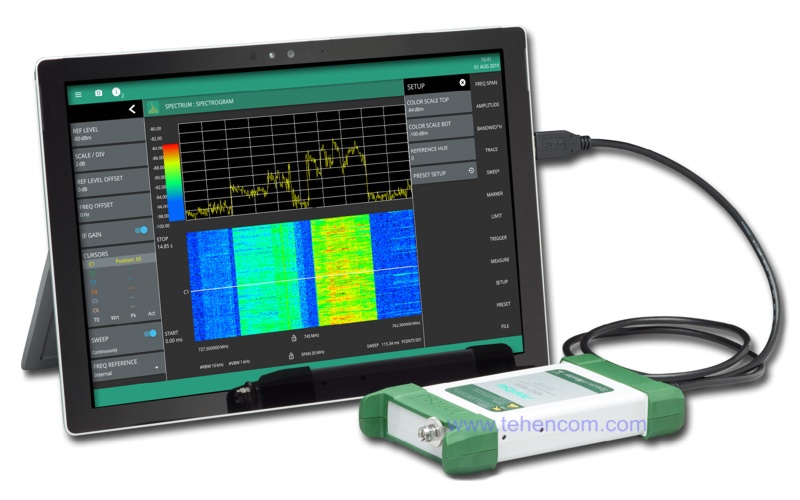
Direct connection to the measurement object
With its compact size and weight of only 255 grams, Anritsu MS276xA analyzers can be directly connected to signal sources, eliminating the need for high-frequency connecting cables, which at frequencies of tens of gigahertz introduce significant attenuation and are very expensive.
As a real example, this photo shows a setup for measuring S-parameters up to 110 GHz using a vector network analyzer Anritsu MS4640B VectorStar and simultaneous spectrum analysis up to 110 GHz using two Anritsu MS2760A ultra-portable spectrum analyzers.
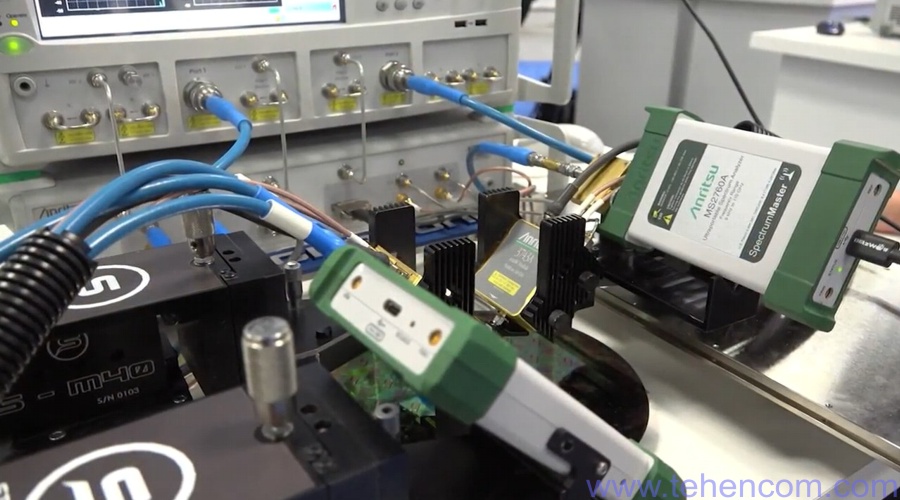
Example of 802.11ad signal measurement at 60 GHz
IEEE 802.11ad radio transmitters operating at 60 GHz are already commercially available. Typically, when testing at such frequencies, a stationary spectrum analyzer and an additional downmixer are used. Using a mixer increases cost, increases amplitude measurement error, and reduces dynamic range.
The MS276xA series handheld spectrum analyzers can directly measure these high frequencies, plus they have over 100dB of dynamic range, allowing full measurements against the IEEE 802.11ad spectrum emission mask. An example is shown in this screenshot.
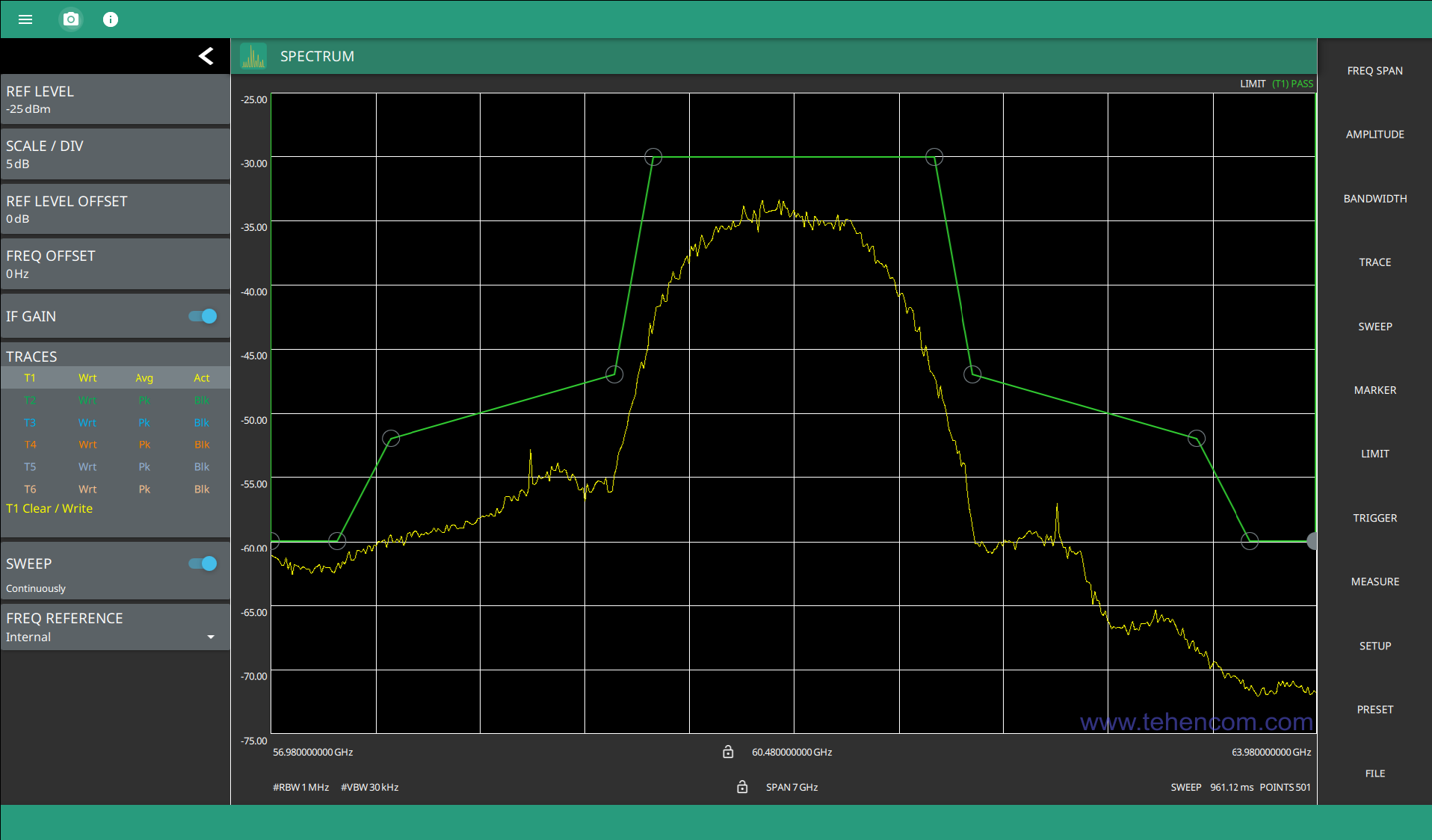
Example of measuring a radar signal at 76.5 GHz
Many modern vehicles are equipped with radars operating at frequencies above 70 GHz and around 24 GHz. These radars are used for adaptive cruise control, blind spot monitoring and collision avoidance, and parking automation. Very often, such radars use FMCW (Frequency Modulated Continuous Wave) pulses, which provide good distance resolution.
The MS276xA series spectrum analyzers can directly measure the characteristics of automotive radar signals, such as start and stop frequency, and FMCW pulse shape. An example of measuring such a signal with a center frequency of 76.5 GHz is shown in this screenshot.
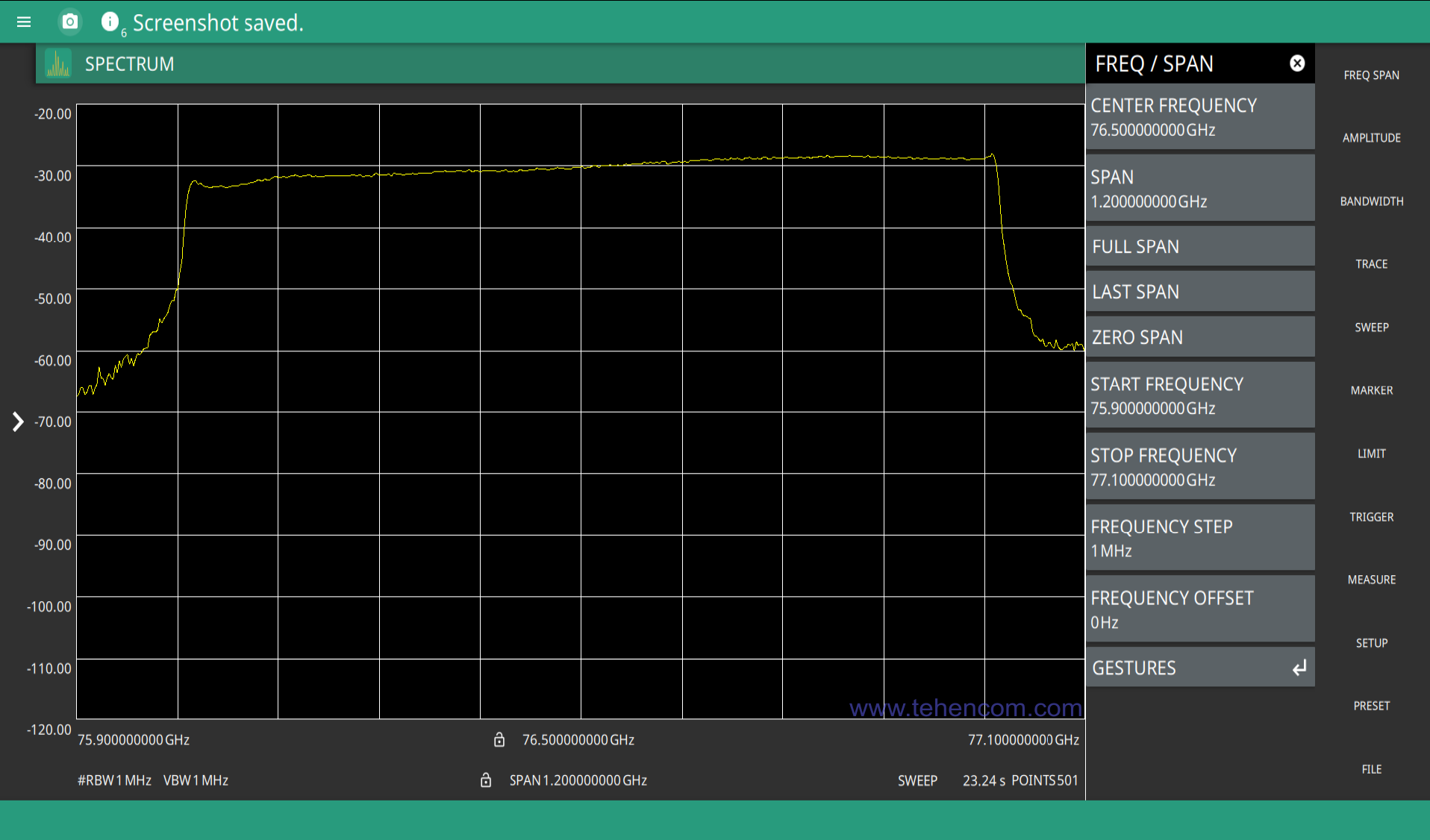
Transient and interference analysis
All spectrum analyzers of the Anritsu MS276xA Spectrum Master series support the display of a continuous sequence of spectra in the form of a spectrogram as standard. This mode, also referred to as the frequency-time diagram, is very useful when looking for intermittent sources of signals or interference, as well as tracking the drift of the amplitude and frequency of radio sources.
This screenshot of the MS276xA analyzer control program shows a section of the spectrum with a width of 50 MHz. At the bottom of the screen is a spectrogram containing 142 consecutive measurements of the spectrum. At the top of the screen are the spectra corresponding to the selected cursor positions. Cursor C1 is set to the current measurement (yellow graph). Cursor C2 is set to measurement #71 (green graph). The total duration of the measurement of all 142 spectra in this case is 8.71 seconds.
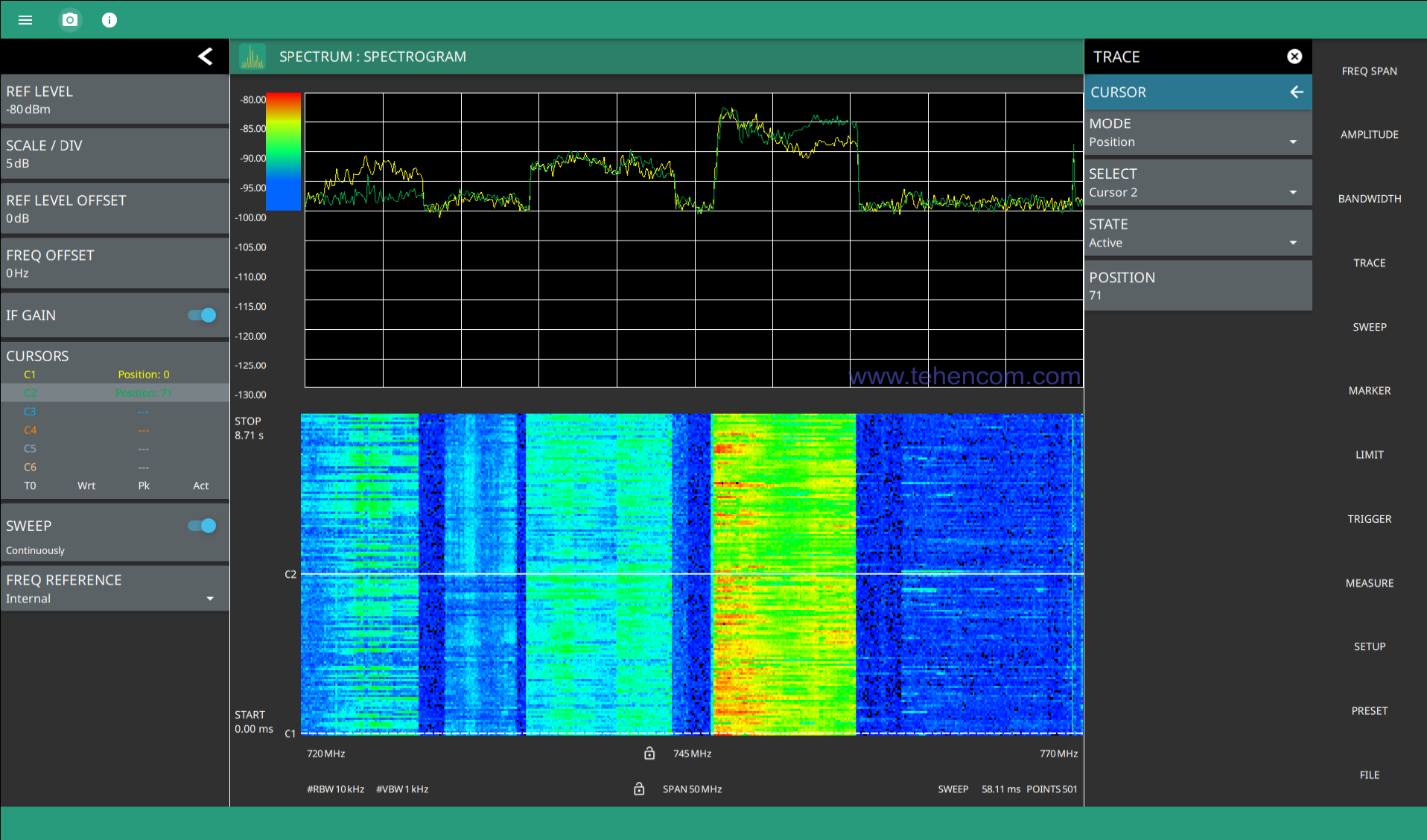
Drawing coverage areas on a three-dimensional map
Due to its compact size, the Anritsu MS276xA spectrum analyzers are excellent for identifying good indoor and outdoor communication coverage areas and automatically plotting them on a building plan or map. In this case, measurements can be carried out, including in the millimeter range.
The MS276xA analyzers are used in conjunction with the MA8100A NEON Signal Mapper to accurately determine coverage areas. The system includes software for a computer (NEON Command Software), software for a smartphone (NEON Signal Mapper) and a special coordinate tracking device (NEON Tracking Unit), which relies on GPS signals, and in their absence (for example, indoors) to the built-in inertial sensor.
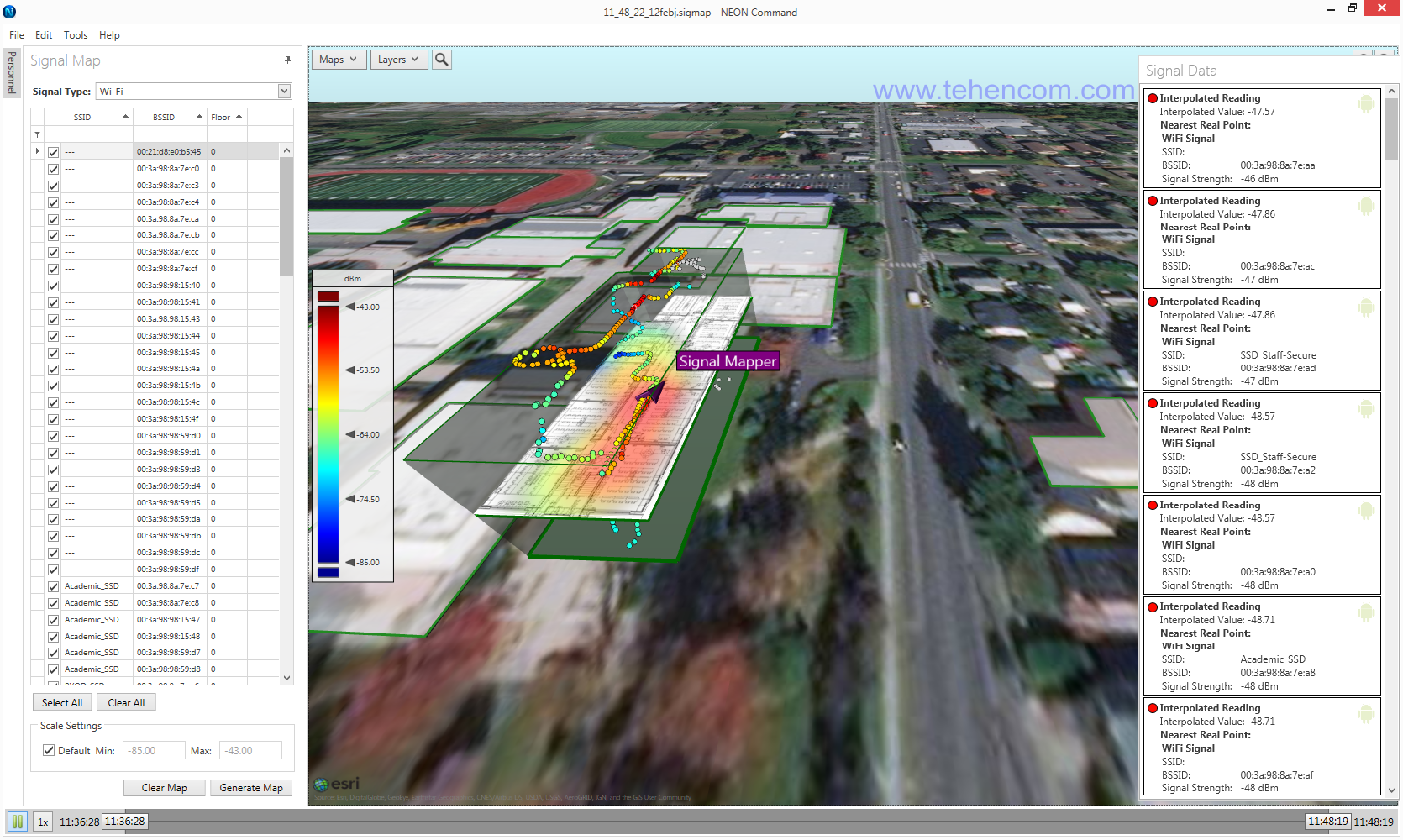
The use of such a kit provides fast and accurate compilation of three-dimensional maps of coverage areas. An example is shown in this photo. The shoulder bag contains a position tracker and a compact Windows laptop to which a MS276xA spectrum analyzer is connected via a USB cable. The laptop runs the NEON Command Software control program, which reads the measurement results from the analyzer and communicates with the smartphone held by the engineer. The NEON Signal Mapper Software data visualization program is running on the smartphone.

Remote control
There are two ways to remotely control the MS276xA series spectrum analyzers. The first and easiest way is using a powerful remote control program Anritsu Spectrum Master Software MS276xA. The program comes free of charge with every spectrum analyzer and has a user-friendly interface and powerful functionality. To run the program, you need a computer or tablet with a USB 3.0 interface, an Intel Core i7 processor and a Windows 7, 8, 10 or 11 operating system.
The second way is writing your own control program using the standard SCPI commands supported by the MS276xA analyzers and detailed in Anritsu MS276xA Spectrum Analyzer User Manual (see below on this page in the section Documentation).
The figure below shows a screenshot of the Anritsu Spectrum Master Software MS276xA remote control program. At the top we see two spectra. Yellow graph – peak detector and averaging are used. Green graph – peak detector and maximum hold are used. In total, up to 6 spectrum graphs can be displayed simultaneously on the screen, each with its own parameters. At the bottom there is a table of markers that help to accurately measure individual points of the graphs. There can be up to 12 markers in total, and they come in three types: regular, fixed and delta marker.
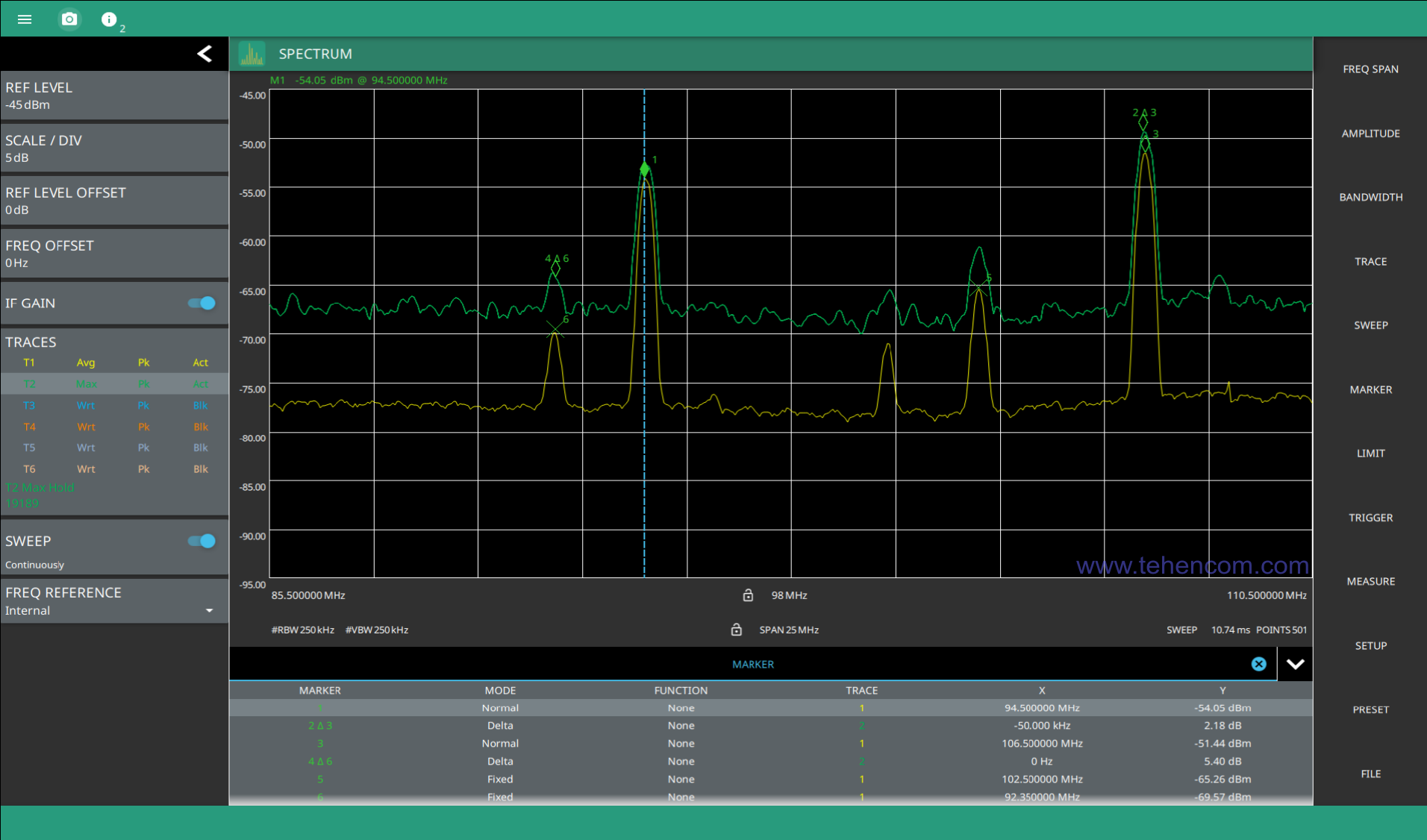
Design features
The photo below shows four angles of the Anritsu MS2760A-0110 (up to 110 GHz). In the lower part of the housing there are: an input for triggering an external clock pulse (TRIG, MCX(f) connector, 50 Ohm), a status LED, a USB 3.0 interface connector and a 10 MHz reference frequency input (REF, MCX(f) connector, 50 Ohm).
At the top of the case is the radio frequency input. The type of RF input connector depends on the maximum frequency of the analyzer. 32 and 44 GHz models use a 2.92 mm (m) connector also called K, 50 and 70 GHz models use a 1.85 mm (m) connector called V, 90 and 110 GHz models uses a 1.0 mm (m) connector called W, while the 145 and 170 GHz models use a 0.8 mm (m) connector. In the name of the connector, the letter (m) means male, that is, pin.
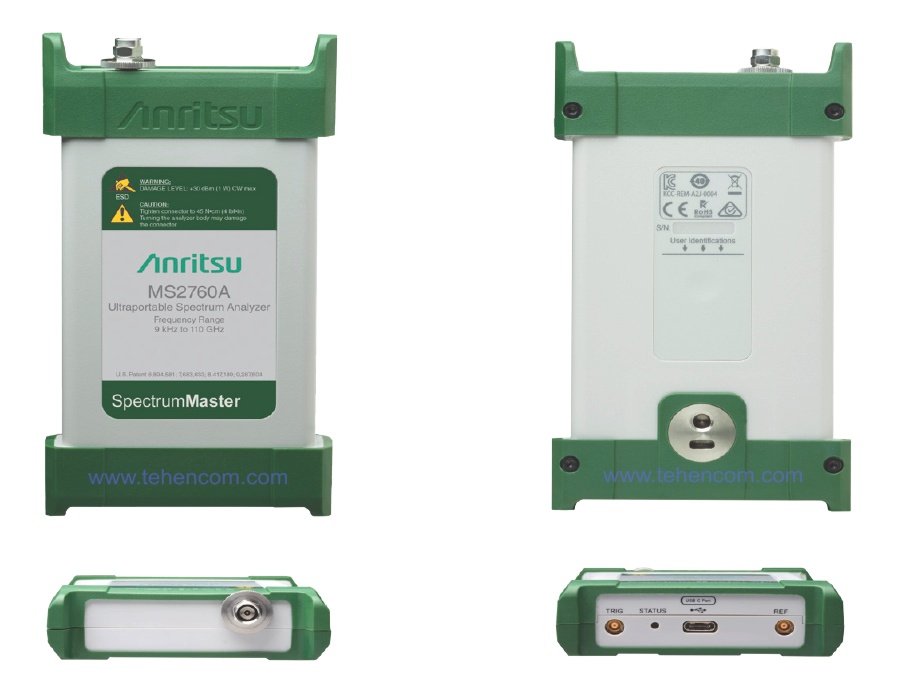
Specifications
This figure provides a list of the main characteristics of eight models of the MS2760A modification (from 9 kHz).
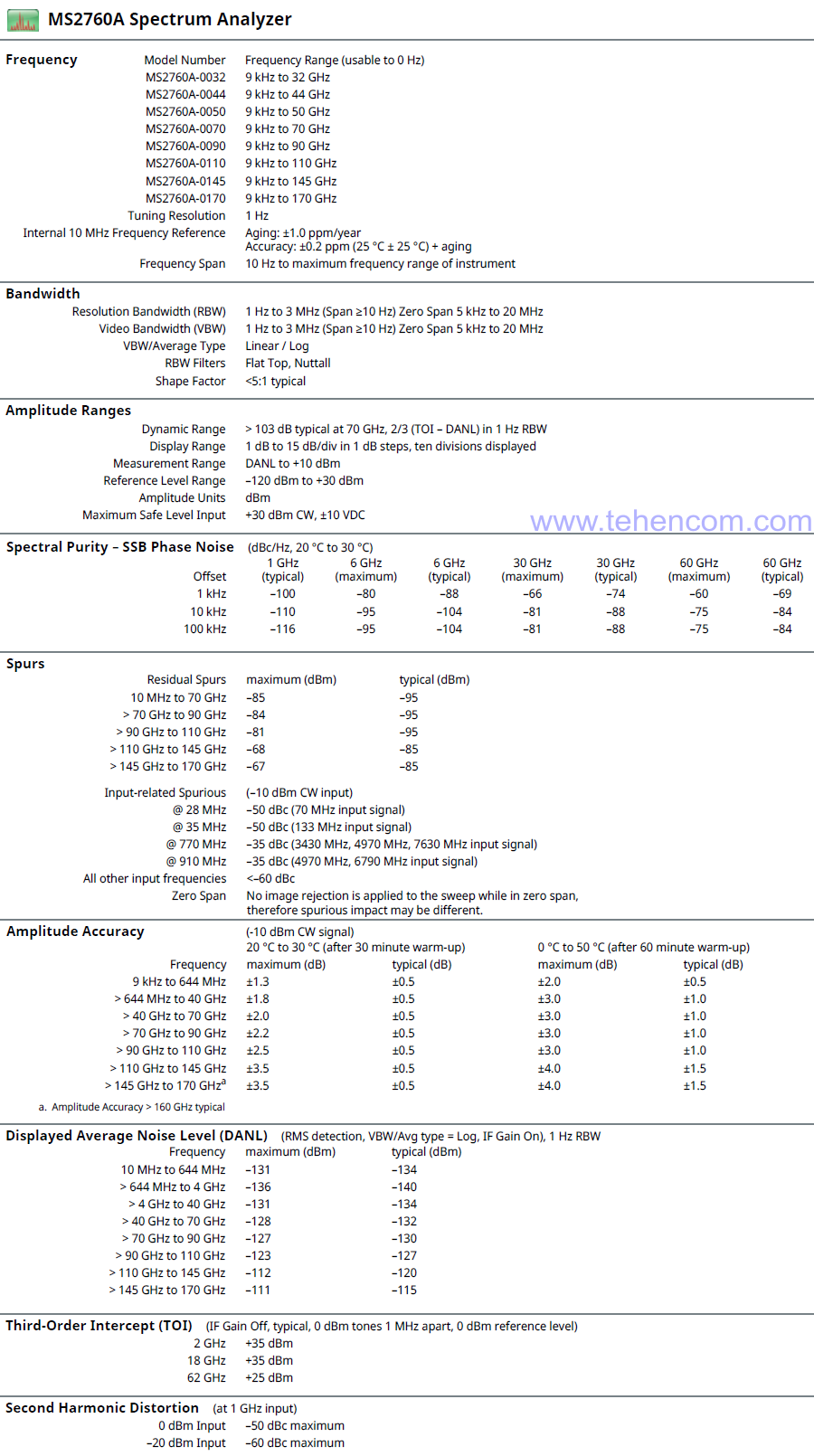
This figure provides a list of the main characteristics of eight models with improved sensitivity of the MS2762A modification (from 6 GHz).
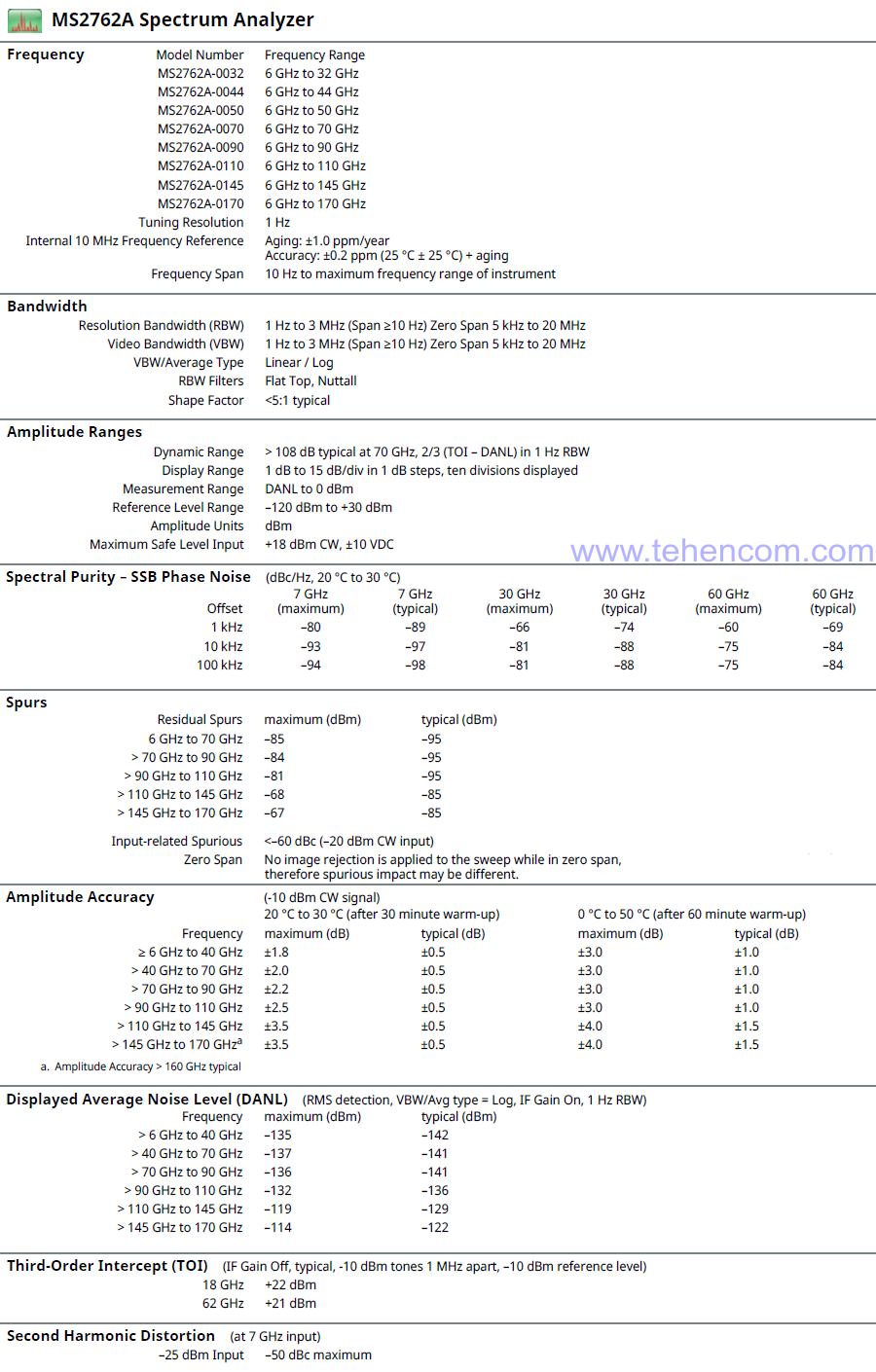
The detailed specifications for the Anritsu MS276xA series spectrum analyzers can be found below on this page in the Documentation section.
Package contents of Anritsu MS276xA
| Name | Short description |
| Anritsu MS2760A-0032 | Ultra-portable spectrum analyzer with operating range 9 kHz to 32 GHz, connector 2.92 mm type K(m) |
| or | |
| Anritsu MS2762A-0032 | Ultra-portable spectrum analyzer with operating range 6 GHz to 32 GHz and improved sensitivity, 2.92 mm K(m) connector |
| or | |
| Anritsu MS2760A-0044 | Ultra-portable spectrum analyzer with operating range 9 kHz to 44 GHz, connector 2.92 mm type K(m) |
| or | |
| Anritsu MS2762A-0044 | Ultra-portable spectrum analyzer with operating range 6 GHz to 44 GHz and improved sensitivity, 2.92 mm K(m) connector |
| or | |
| Anritsu MS2760A-0050 | Ultra-portable spectrum analyzer with operating range 9 kHz to 50 GHz, connector 1.85mm type V(m) |
| or | |
| Anritsu MS2762A-0050 | Ultra-portable spectrum analyzer with operating range 6 GHz to 50 GHz and improved sensitivity, 1.85 mm V(m) connector |
| or | |
| Anritsu MS2760A-0070 | Ultra-portable spectrum analyzer with operating range 9 kHz to 70 GHz, connector 1.85mm type V(m) |
| or | |
| Anritsu MS2762A-0070 | Ultra-portable spectrum analyzer with operating range 6 GHz to 70 GHz and improved sensitivity, 1.85 mm V(m) connector |
| or | |
| Anritsu MS2760A-0090 | Ultra-portable spectrum analyzer with operating range 9 kHz to 90 GHz, connector 1.0 mm type W(m) |
| or | |
| Anritsu MS2762A-0090 | Ultra-portable spectrum analyzer with operating range 6 GHz to 90 GHz and improved sensitivity, 1.0 mm connector type W(m) |
| or | |
| Anritsu MS2760A-0110 | Ultra-portable spectrum analyzer with operating range 9 kHz to 110 GHz, connector 1.0 mm type W(m) |
| or | |
| Anritsu MS2762A-0110 | Ultra-portable spectrum analyzer with operating range 6 GHz to 110 GHz and improved sensitivity, 1.0 mm connector type W(m) |
| or | |
| Anritsu MS2760A-0145 | Ultra-portable spectrum analyzer with operating range 9 kHz to 145 GHz, connector 0.8 mm (m) |
| or | |
| Anritsu MS2762A-0145 | Ultra-portable spectrum analyzer with operating range 6 GHz to 145 GHz and improved sensitivity, 0.8 mm connector (m) |
| or | |
| Anritsu MS2760A-0170 | Ultra-portable spectrum analyzer with operating range 9 kHz to 170 GHz, connector 0.8 mm (m) |
| or | |
| Anritsu MS2762A-0170 | Ultra-portable spectrum analyzer with operating range 6 GHz to 170 GHz and improved sensitivity, 0.8 mm connector (m) |
| plus: | |
| 2000-1859-R | USB 3.0 Type C to Type A cable (1 meter) |
| 2000-1605-R | BNC(m) - MCX(m) cable (2 pcs.) for connection to the frequency reference input and external clock trigger input of the MS276xA analyzer |
| - | User manual in electronic form |
| - | PC control software for MS276xA analyzer |
| - | Calibration certificate |
| - | 1 year warranty (can be extended to 3 and 5 years) |
Options and accessories for Anritsu MS276xA
Spectrum Analyzers Anritsu MS276xA are fully operational as standard. There are currently no hardware or software options available for them. A list of the main accessories for the MS276xA analyzers is given below. You can also choose auxiliary equipment from the following sections of our website: Measuring antennas and Microwave accessories.
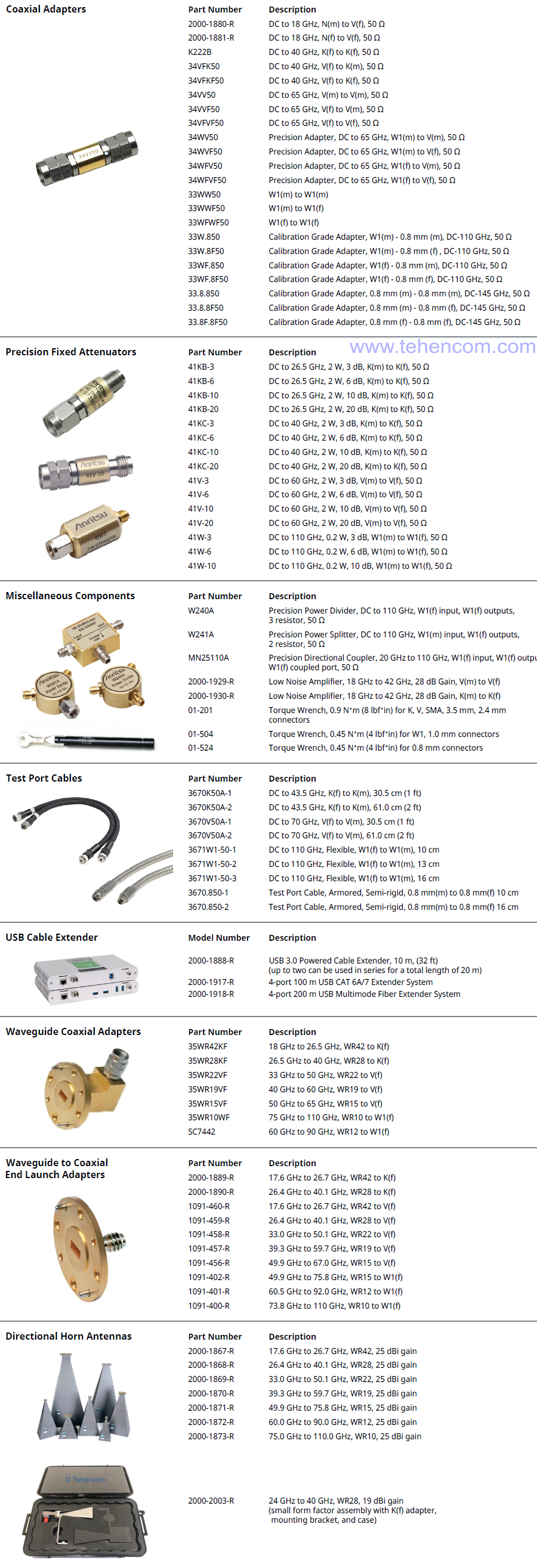
Documentation
This PDF documentation contains the most comprehensive description of Anritsu's MS276xA Series ultra-portable spectrum analyzers, their specifications and modes of operation.
Spectrum analyzer description Anritsu MS276xA (in English) (15 pages; 5 MB)
Anritsu MS276xA spectrum analyzer specifications (in English) (15 pages; 2 MB)
Brief information about modification of Anritsu MS2760A analyzers (in English) (2 pages; 1 MB)
Brief information about modification of Anritsu MS2762A analyzers (in English) (2 pages; 1 MB)
Anritsu MS276xA spectrum analyzers user manual (in English) (164 pages; 9 MB)
Low noise amplifier specifications for Anritsu MS276xA (4 pages; 2 MB)
And here you can find our tips and other useful information on this topic:
A brief overview of all series of Anritsu RF measuring instruments
An overview of all series of Anritsu handheld RF analyzers
Basic theory for spectrum analysis and signal analysis
How to buy equipment cheaper – discounts, special prices, demo and used devices
To simplify the process of choosing a spectrum and signal analyzer, you can use our experience and recommendations. We have over 20 years of practical supply experience and can immediately answer many questions about models, options, delivery times, prices and discounts. This will save your time and money. For this it's simple call us or write to us at E-mail and we will be happy to answer your questions.
